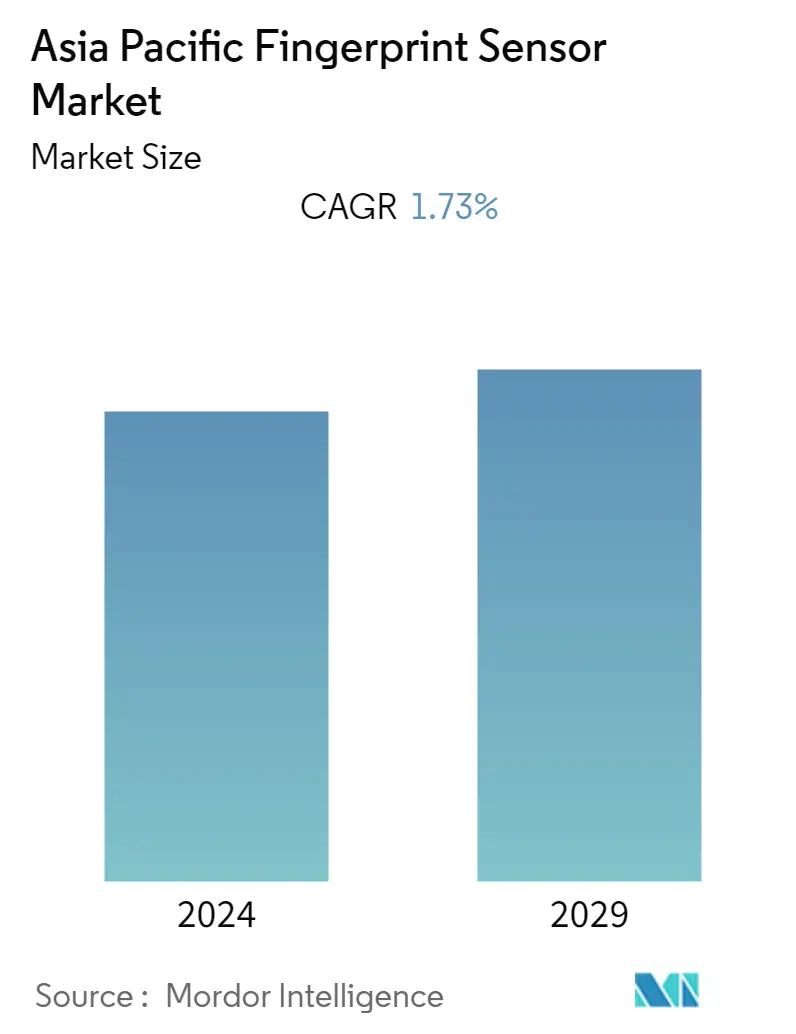Market Size of Asia Pacific Fingerprint Sensor Industry

| Study Period | 2019 - 2029 |
| Base Year For Estimation | 2023 |
| Forecast Data Period | 2024 - 2029 |
| Historical Data Period | 2019 - 2022 |
| CAGR | 1.73 % |
| Market Concentration | Medium |
Major Players
*Disclaimer: Major Players sorted in no particular order |
Need a report that reflects how COVID-19 has impacted this market and its growth?
Asia Pacific Fingerprint Sensor Market Analysis
The Asia Pacific fingerprint sensor market is expected to register a CAGR of 1.73% during the forecast period (2020 - 2025). Increasing mobile transactions in region, coupled with the government's initiatives, are expected to be the major drivers for the fingerprint sensors market in the country. China is witnessing a high mobile transactional volume, which is expected to create potential for the market studied.
- The robust consumer electronics manufacturing ecosystem in China is another important factor fueling the market growth. According to the European Council, China accounts for over 38% of the global consumer electronics market. Major smartphone companies, including Huawei, Apple, Samsung, Xiaomi, and Lenovo, have their manufacturing facilities in the country. With the continuous increase in smartphone sales, the demand for fingerprint sensors that are embedded in smartphones is expected to increase in the region.
- In Asia, China and India have built the world's largest biometric database with initiatives, such as Aadhar and Social Credit Systems. Aadhar is a 12-digit unique number based on the citizen's photograph, iris scans, and ten fingerprints, and as of January 2020, 1,250,784,712 have an Aadhaar number covering 99% of the country's population.
- With the advancements in the field of biometric technology, the region is embracing this technology for authentication. For instance, as per the HSBC's Trust in Technology report, India leads among all other countries surveyed (11 countries surveyed) in the adoption of biometric technology. On average, people in India (9%) are three times more likely than other countries (3%) surveyed to have utilized iris recognition for identifying themselves. Overall, it is about time to see if the advanced biometric technologies like iris would take over the share of fingerprint in the region.
- The Japanese companies in the automotive sector are also actively looking forward to integrating fingerprint sensors in their upcoming models. For instance, Nissan introduced its concept car Nissan Xmotion featured with fingerprint biometric authentication for enhanced security of the vehicles.
- Some of the noticeable companies in the region are entering into strategic partnerships that allow them to further develop the technology, thereby, fueling the demand for the technology over the forecast period. For instance, a new joint venture company has been formed to develop and market next generation biometric applications, through a partnership between Datasonic and South Korea-based Digent.
- With the recent outbreak of COVID 19, the fingerprint sensor market is witnessing a decline in growth due to various organizations and government authorities restricting the usage of biometric systems in their respective premises. For instance, in February 2020, South Korea banned the usage of fingerprint scanners across all government and private organizations owing to the COVID virus that is spread through touchpoints.
